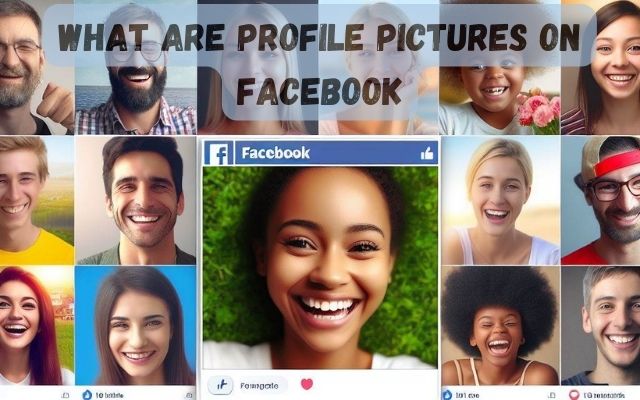What are profile pictures on facebook
Unraveling the Significance of Facebook Profile Pictures

In the digital age, profile pictures on Facebook have become a significant aspect of our online presence. They serve as a virtual introduction, a digital handshake if you will, that can set the tone for how we are perceived in the vast landscape of social media.
Facebook, a platform with billions of users worldwide, has revolutionized the way we connect and communicate. At the heart of this interaction lies the profile picture, a powerful tool that plays a pivotal role in shaping our online identity.
A profile picture on Facebook is more than just a photo. It’s a representation of an individual, a brand, or an organization. It’s the first thing people see when they visit your profile or come across your comments. It can convey a range of information, from personal tastes and hobbies to professional affiliations and achievements.
The choice of a profile picture is a personal decision, influenced by various factors such as culture, personality, and the desire for privacy. Whether it’s a carefully posed selfie, a logo, or even a beloved pet, each profile picture tells a unique story.
In the following sections, we will delve deeper into the world of Facebook profile pictures, exploring their significance, the psychology behind them, and the ethical considerations involved. Stay tuned as we unravel the fascinating world of these digital identities.
Remember, the power of a profile picture extends beyond the confines of Facebook. It’s a part of your digital footprint, a reflection of your online persona. So, choose wisely!
You can create facebook profile picture by PFPMaker at PFPMaker com.
Understanding Profile Pictures
A profile picture on Facebook serves as a crucial element of your online identity on the platform. It acts as the initial visual representation that visitors encounter when exploring your profile or viewing your comments.
To set or modify your profile picture, navigate to the top right of Facebook, click on your existing profile picture, and then select your profile name. Subsequently, you can either choose an existing photo or upload a new one. Additionally, Facebook provides options to create an avatar profile picture or add a frame to an existing image.
Users can opt for various types of profile pictures, such as personal photos, business logos, or group images. The decision often hinges on the user’s purpose on the platform. For instance, a business page may use a logo to bolster brand recognition, while an individual might prefer a personal photo for easier identification by friends.
When you add or modify your profile picture, it may appear in several locations on Facebook. It will be visible on your profile, potentially showing up in your friends’ Feeds. Furthermore, your profile picture is stored in your Profile Pictures album. A thumbnail version of it will be displayed alongside your name in various sections across Facebook, aiding friends in recognizing your posts and comments.
It’s crucial to be aware that your current profile picture is always public, meaning it can be viewed by anyone, whether they are on or off Facebook. However, you have the option to adjust the privacy settings for photos used as profile pictures in the past.
The Significance of Profile Pictures
Profile pictures on Facebook transcend mere visual representations; they are a form of self-expression and a vital component of one’s online identity. Carefully chosen, these images reflect how users perceive themselves and desire to be seen by others.
The importance of profile pictures permeates various facets of Facebook interactions. They play a pivotal role in connecting with friends and family, providing a familiar face that facilitates identification and connection. It serves as the initial impression for those visiting your profile or encountering your comments.
In the professional arena, profile pictures wield influence over networking opportunities. A professionally curated image can attract potential employers or business partners, conveying information ranging from personal tastes to professional affiliations and achievements.
Additionally, profile pictures can offer insights into a person’s personality. Research from the University of Pennsylvania reveals that certain personality traits influence the choice of profile pictures. Extroverts, for instance, lean towards vibrant photos showcasing positive emotions and often prefer group shots.
Conversely, individuals high in neuroticism, associated with negative emotions and emotional insecurity, tend to avoid presenting faces or opt for significantly larger images or obscured faces with glasses.
Interestingly, the scope of profile picture choices extends beyond human subjects to include pets. The World Well-Being Project notes a trend where people choose images of cats and dogs for their Twitter profiles, a pattern that could potentially extend to Facebook.
Facebook profile pictures carry substantial weight in shaping a user’s online identity and influencing social interactions. Serving as a powerful tool, they convey a wealth of information about the user, solidifying their integral role in the Facebook experience.
The Psychology Behind Profile Pictures
Profile pictures on Facebook serve as more than mere images; they act as deliberate public expressions of self. These visual representations not only reflect how individuals perceive themselves but also convey the desired perception to others, making them a captivating subject for psychological analysis.
A research team from the University of Pennsylvania delved into the intriguing realm of profile pictures, discovering that specific personality traits significantly influence the choice of images. Extroverts, characterized by sociability, lean towards vibrant photos radiating positive emotions, often featuring group settings to mirror their outgoing nature.
Conversely, neurotic individuals, marked by negative emotions and emotional insecurity, exhibit a reluctance to showcase faces in their profile pictures. When faces are present, they are often obscured or enlarged, accompanied by less positive facial expressions, providing insights into their unique tendencies.
Individuals with high conscientiousness, associated with orderliness and planned behavior, tend to adhere to social norms in their profile photos. Displaying smiles and maintaining well-proportioned, high-quality images, they project an image of happiness in accordance with societal expectations.
Agreeable personalities, driven by a pursuit of social harmony and cooperation, manifest their traits in profile photos marked by frequent displays of positive emotions. Although their images may be blurrier compared to conscientious users, they compensate with vibrant colors, reflecting their agreeable disposition.
Those characterized by openness to experience diverge from conventional norms, opting not to prominently feature faces in their profile pictures even more than neurotic individuals. Despite exhibiting negative or neutral emotions, their photos boast enhanced aesthetic qualities such as increased contrast and sharpness, signaling a preference for uniqueness and non-conformity.
Intriguingly, the World Well-Being Project uncovered a trend where individuals choosing photos of cats and dogs for their Twitter profiles, possibly extending to Facebook, align with broader psychological patterns. This highlights the notion that profile pictures extend beyond personal representation to include images that individuals perceive as suitable for shaping their online persona.
Ethical Considerations and Privacy
In the digital age, safeguarding privacy has emerged as a critical concern, with Facebook finding itself in the midst of this discourse. Specifically addressing profile pictures, Facebook has instituted various measures to fortify user privacy.
Currently, your profile picture and cover photo on Facebook are set to public visibility, accessible to both Facebook users and non-users alike. However, the platform allows users to fine-tune the privacy settings for previously used profile pictures or cover photos, providing a mechanism for controlling visibility.
Despite these precautions, ethical concerns manifest when profile pictures are exploited, particularly in the context of identity theft. Unscrupulous actors can manipulate profile pictures to fabricate deceptive accounts, thereby posing a risk of harm and confusion. Facebook, cognizant of such threats, maintains stringent policies, including rules against impersonation. Users encountering their photos used inappropriately are encouraged to report such incidents to initiate remedial action.
Furthermore, the ethos of privacy and consent is imperative in the realm of profile pictures. It is incumbent upon users to honor others’ preferences and refrain from posting pictures without explicit consent. This aspect gains heightened significance in the case of images featuring minors or vulnerable individuals, warranting a heightened sense of responsibility.
Ethical design principles play a pivotal role in shaping the user experience around profile pictures. One noteworthy suggestion involves incorporating a counter beneath the profile picture to display the active browsing duration, fostering awareness of screen time. This innovative approach aligns with a broader commitment to responsible digital practices.
While profile pictures serve as a fundamental element of our online identity, their usage demands a conscientious approach. Responsible behavior entails not only protecting our own privacy but also respecting the ethical considerations associated with the digital representation of others. By staying vigilant and adhering to ethical guidelines, users can contribute to a digital landscape that values privacy and upholds ethical standards.
FAQ
What is meant by a profile picture?
A profile picture is a photo that users upload to their social media profile to represent their identity. It provides a glimpse into the personality and interests of the user. Each social media platform has a unique way of displaying the profile picture, usually next to the account name on posts, comments, and on the main user profile.
Where are Facebook profile pictures located?
Facebook profile pictures can be found in the top right of Facebook, by clicking on your profile picture, then clicking your profile name. They appear in your Profile Pictures album and as a thumbnail version next to your name in different places throughout Facebook.
What is a personal profile picture?
A personal profile picture is a photo that appears in your online accounts, regardless of whether it’s a social media or professional site. It is a conscious representation of oneself in the eyes of the world. It could be a headshot, a photo of a memorable moment, or any image that the user feels best represents them.
What is the difference between a profile picture and a display picture?
A profile picture is the image that represents a social media account in all its interactions across a platform. On the other hand, a display picture is what users see on the screen of their device, whether it’s a desktop monitor, smartphone, or a tablet.
Are all my profile pictures public on Facebook?
Yes, your current profile picture and cover photo on Facebook are public, so they can be seen by anyone on or off Facebook. However, you can adjust the privacy settings for a photo you’ve used as a profile picture or cover photo in the past.
Who can like my profile pictures on Facebook?
By default, only your friends (and friends of anyone tagged) can like or comment on your public profile information on Facebook. However, you can adjust who can like or comment on your public profile information.
Why do people change their profile pictures frequently?
People who frequently change their profile pictures might be insecure, seeking attention, or potentially going through personal changes. They might be unsatisfied with their life, exploring their identity, or wanting to present different aspects of themselves to others.
How do I change my profile picture on Facebook?
On Facebook, click your profile picture in the top right, then click your profile name. Click in the bottom right of your profile picture, and from here, you can select a photo or upload a new one. On Windows, select Start > Settings > Accounts > Your info. Under Adjust your photo, select Choose a file > Browse files to select an existing photo.
Conclusion
In the digital age, profile pictures on Facebook have become a significant part of our online identity. They are more than just images; they are a form of self-expression and a reflection of our personality.
Whether it’s a personal photo, a business logo, or a group image, each profile picture tells a unique story. They play a crucial role in shaping our online identity and social interactions. Profile pictures can convey a wealth of information about the user, making them an integral part of the Facebook experience.
However, with the increasing significance of profile pictures, it’s essential to use them responsibly. We must respect privacy and ethical considerations, be aware of the potential risks, and take steps to protect our privacy and that of others.
As we move forward, the role of profile pictures on Facebook is likely to evolve. With advancements in technology and changes in social media trends, the way we use and perceive profile pictures may change. But one thing is certain – profile pictures will continue to be a powerful tool for self-expression and communication in the digital world.






